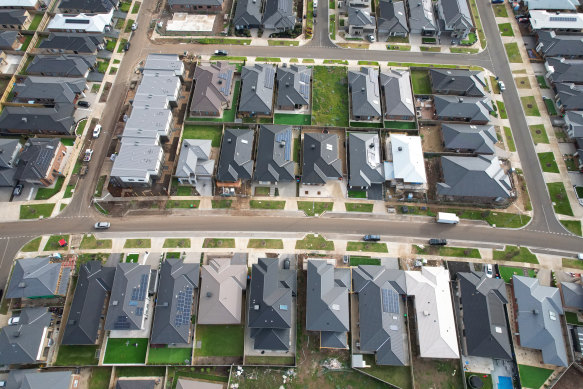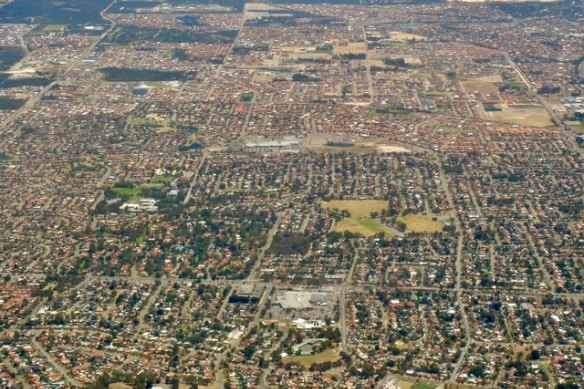This was published 1 year ago
Opinion
How we’ve ruined suburbia: homes twice as big on blocks half the size
Tone Wheeler
Australian Architecture Association presidentI grew up in suburban Melbourne and Sydney in the 1960s. I was lucky. You could walk or cycle to schools and shops; lots of places to explore; modest bungalows on large blocks with backyards for play, and sport with local children; birthday parties under Hills Hoist tents; the beach was close by bus or tram.
It’s a world away from contemporary suburbia: far from the city centre and water, without public transport, schools or shops; tiny blocks of land with huge, sealed-up two-storey houses; no backyards or gardens, no trees, and 5 degrees hotter than the inner suburbs.

Bigger homes on smaller blocks pose some problems, such as room for trees and harnessing sunlight.Credit: Jason South
How did we traduce the great idea of suburbia? In the past 60 years, every critical characteristic of suburban houses has changed by a factor of two: sometimes doubled, sometimes halved, but the net effect has been the loss of all the good qualities of suburbia. It’s 2 x 2 x 2 x 2 x 2 x 2 x 2.
Land is so expensive at the edge of the city that subdivisions are half the size of the 1960s quarter-acre (1000 square metres) block, often smaller at 350 to 400 square metres. The sites are skinny to minimise the length along the street and sites so small that the houses are oriented to the boundaries, not the sun. The houses are so crowded on the sites that passive solar is not possible, and cross-ventilation breeds a loss of privacy, so air-conditioning is the norm.
Meanwhile, the house area doubled from about 120 to 240 square metres, prompted by both a reduction in the quality of construction materials and the demand by purchasers for houses as large as possible. Children may have shared a bedroom and one bathroom in the past (I did). Now they have a bedroom and ensuite each; one living room for the whole family has given way to separate family areas just for the children.
When a house twice the size goes on a block half the size, it can no longer be a bungalow. It doubles to two storeys, and even then, it has a tiny garden, with no room for trees. The two storeys built to the boundaries overshadow the neighbours and invade their privacy. The increased bulk and absence of trees creates dominant forms in the street where once street trees hid the single-storey bungalows.
The narrow fronts, with much of the frontage occupied by huge garage doors, tell of another doubling. In the 1960s, the family had one car: Holden Commodore or Ford Falcon (my family were anarchic separatists with an AP6 Valiant). Now the family has two or more cars, bought as soon as you can drive. Parked on the front driveway, the front lawn, the nature strip (weird term), cars are necessitated by the lack of public transport in the outer suburbs: no trams, no trains, and privatised bus services that are hopelessly inadequate.
The houses are now doubled in glazing area. Project homes of the ’60s had glazed areas totalling 10-15 per cent of the floor area, as dictated by Ordinance 70 and the like. The glazing ratio has increased to upwards of 30 per cent. To pass the national home energy rating scheme, NatHERS, it should be double-glazed, but often isn’t.

The great Australian dream?
Where once one refrigerator in the kitchen was sufficient, now there are two or more refrigerators in the family room or garage to store booze, soft drinks, bait, fish and the like. The second fridge is often older, more inefficient, with polluting refrigerants. After hot water, refrigerators are the biggest consumer of electricity.
Where one TV in the house once sufficed, now it’s one in every room. Many other appliances have doubled or proliferated: ovens, microwaves, blenders, computers, heated tower rails, hair dryers, fish tanks, along with many more lights.
But the sustainability killer is the number of people living in the house. In the ’60s, the average occupancy was more than five. Now it’s less than half that, at 2.5.
In the ’60s, the majority was families, parents and children, sometimes multi-generational, and maybe board and lodging for a student (in every house we lived in). Now singles and couples outnumber families. Large houses on small blocks may only have a couple of people in them.
Not that all ’60s suburbs were great. There were failures, such as the “Radburn” experiments in Curtin and Charnwood in the ACT, and Cartwright and Crestwood in NSW. But nothing failed on the scale of the vast, dark-roofed, treeless, overheated suburbs that have recently been built at the edges of our cities. This change didn’t take place overnight; it took 60 years to destroy the high quality of the original suburbs.
This article first appeared at architectureanddesign.com.au
The Opinion newsletter is a weekly wrap of views that will challenge, champion and inform your own. Sign up here.